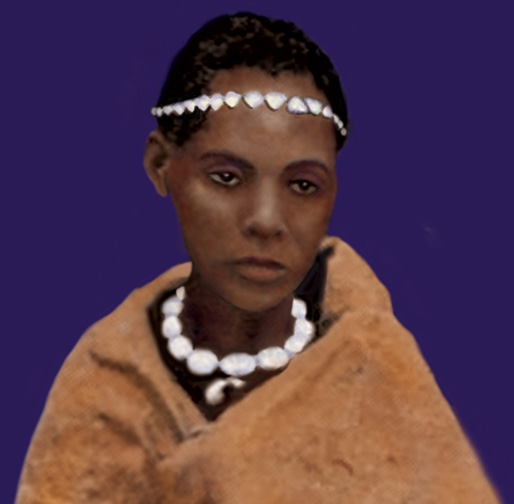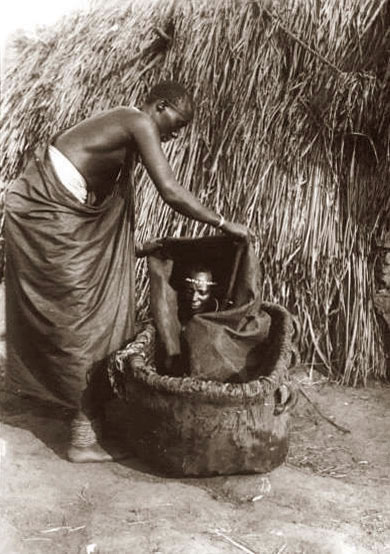Muhumusa
oracle of Nyabingi, UgandaMax Dashu
She appears in the early 1900s as a widowed Rwandan queen mother exiled by the usurper Mwame Musinga, who had seized her son’s throne in alliance with German colonizers. She fled to Ndorwa in the mountains of southeast Kigezi, Uganda. In those hills she searched for the magical golden drum Mahinda, with its ivory sticks, which had belonged to a BaKiga clan elder.
Muhumusa became a mugirwa (spirit oracle) guided by the ancestral queen Nyabinghi, and a charismatic healer. She attained the rank of chief, forging ties to local leaders, and soon led an anti-colonial movement “with a vast popular following,” opposing Tutsi chiefs aligned with European powers.The legend of Queen Nyabinghi began with an amazon queen named Kitami, who possessed a sacred drum. She governed the southern region of Uganda, known as Mpororo. A man named Kamurari stole her sacred drum and founded a dynasty, but later generations revered Kitami as a powerful ancestor (emandua). The spirit of Nyabinghi selected the bagirwa, who were “predominantly curers,” to be her oracles.
The women prophesied behind a barkcloth veil, entering into ecstatic states with "stylized trembling movements." They prophesied in obscure, archaic language, in high-pitched voices, holding dialogues with Nyabingi and speaking her replies, in her name. [Hopkins, 259] Many of the bagirwa (singular mugirwa) lived in a sacred hut in relative seclusion. Some were carried on litters (a royal attribute) “shrouded in bark cloth with their faces veiled.” [Hopkins, 260]A rare photo shows Muhumusa, or perhaps another mugirwa,
seated in a large basket while a barkcloth is being lowered
over her in preparation for the prophecy.
The bagirwa “were almost invariably women” according to Sir John Milner Gray, but some males also held this office, wearing female dress (it is not clear whether their feminine presentation amounted to a permanent social identity or was undertaken for ceremonial purposes.) [Hopkins, 263] These traditions long predated Muhumusa. The bagirwa had enough power to demand tribute from chiefs, disrupting the tribute patterns in Rwanda, and they distributed cattle and beer, as chiefs did.
In the late 1800s, foreign travellers in the Uganda / Rwanda borderlands heard people talking about these holy women. The colonial explorer H. M. Stanley heard reports of an Empress of Ruanda (although women in that kingdom did not officially rule). He was also told about the Wanyavingi (“people of Nyavingi,” one of many variants on Nyabinghi recorded by outsiders).
Another British account mentions cattle “now with Navingi, chieftainess of Omupundi.” [Hopkins, 1970: 264-247] In 1891, Emin Pasha reported from Mpororo that Muhumusa was never seen, “a voice behind a curtain of bark cloth, with the reputation of a great sorceress.”Muhumusa became the first in a line of rebel priestesses who fought colonial domination in the name of Nyabinghi. In 1911 Muhumusa proclaimed “she would drive out the Europeans” and “that the bullets of the Wazungu [Europeans] would turn to water against her.” She roused a military resistance which was stamped out within months. Still the colonizers considered her such a political threat that she spent the rest of her life under detention at Kampala— first at the behest of the Germans, then of the British (1912-1945).
The British passed their 1912 "Witchcraft Act" as direct response to the political effectiveness of Muhumusa and her spiritually-based resistance movement. It did not die with her captivity, however. New figures rose to take her place, as British colonial records show:
1913: Mention of “several female ‘witches’ of the Mamusa type”
1912-1938: The male rebel Ndungutsi remained a thorn in the side of the colonizers for decades.
1914: Changandusi, another royal female mugirwa, with her son
1915: An unnamed female mugirwa with the message, "Drive out the English."
1916: Another unnamed female mugirwa from eastern Congo
1916: The male mugirwa Ndochibiri led a revolt
1917: The great Nyakishenyi revolt headed by the female oracle Kaigirwa
1919 Kaigirwa led another insurrection
1919: Mention of a “Rwandan Nabingi”
1919: In July “a priestess” in Ruzumbura was jailed, then exiled
1922: A female mugirwa in Kigezi calls to “drive out the whites.” The people protected her and she was never captured.
1928: Widespread rebellion led by a mugirwa who was a chief’s mother. The British jailed her but people succeeded in protecting the sacred drum, chair and iron, which remained at largeKaigirwa was one of the most prominent of the many bagirwa oracles of Nyabingi. In August 1917, this “Nabinga” engineered the Nyakishenyi revolt, with unanimous public support. British officials placed a high price on her head, but no one would claim it. One commissioner remarked, “These fanatical women are a curse to the country.” That was the British perspective; but the people regarded the bagirwa as their best hope to avoid being ruled by foreign powers.
In January of 1919, colonial forces attacked the Congo camp of Kaigirwa, her husband Luhemba, the male mugirwa Ndochibiri and others. The men died in battle, defiantly breaking their rifles and cursing their enemies. But Kaigirwa and the main body of fighters managed to evade the army and escape. The British captured the sacred white sheep, and summoned a convocation of leading chiefs to watch them burn it to dust. They lectured their captive audience “not to listen to Kaigirwa who will only lead them to trouble.”
But a series of disasters afflicted the District Commissioner who had killed the sheep. His own herds were wiped out, his roof caved in and a mysterious fire broke out in his house. Two years later, Kaigirwa attempted another rising. When it failed, she disappeared into the hills, and was never captured.One official wrote “that a very serious general rising … had been most narrowly averted.” Another referred to “the narrow escape… from a serious native outbreak” and deplored the danger of “this Nabingi propaganda.” Other revolts followed. The most serious was the 1928 Rebellion, which began with the killing of puppet chiefs and “large, excited and armed gatherings in the hills.” One British official described these as "armed witchcraft dances." The Witchcraft Act continued to be used to repress popular resistance to empire.
Multiple risings were suppressed, one after another, over decades, into the 1930s. At that point, the missionaries began to make headway in converting people to Christianity. This shift had strong political dimensions. Some converts were not above pressuring people into baptism by declaring that pagans would be under suspicion for political subversion. The political aspect of the bagirwa gradually faded, and their underlying healing culture reasserted itself.
But there was one more chapter to follow. Although the British quelled the Nyabinghi movement in East Africa, it inspired Diasporic Africans in another colony in that vast empire. In Jamaica, the Rastafarians learned of what was happening in Uganda. They were attuned to East Africa because of their allegiance to the king of Ethiopia, Ras Tafari.
The Rastafarians adopted Queen Nyabingi as a spirit of liberation whose power would overcome downpressors. The Order of Nyabingi became an important cultural touchstone. Drumming and chanting Nyabingi became a powerful means of overcoming oppression and injustice, a unifying Pan-African theme of the Caribbean.
Primary source: Elizabeth Hopkins, “The Nyabingi Cult of Southwestern Uganda” in Protest and Power in Black Africa, ed. Robert Rotberg and Ali Mazrui, New York: Oxford, 1970
Other prophetesses:
Dahia al-Kahina, Amazigh prophetess, Aurès mountains, TunisiaEssie Parrish, yomta and Bole Maru Dreamer, Kashaya Pomo, Stewarts Point, California
Mauricia la Bruja, prophetess of the Old Ways, Venezuela
Teresa Urrea, la Santa de Cabora, healer and revolutionary seeress, Sonora, Mexico, El Paso, Texas, and Clinton, Arizona.
Libuše, prophetess, tribal judge, and founder of Prague, Czechia
Pau, kaula wahine / seeress, Hawai'i
The Prophetic Women poster is 18 x 24 inches on high quality heavy stock.
Gift. Pay shipping only for one copy ($4 in USA, $14 to all other countries).
Order here. To pay securely with your credit card, look for the gray Checkout button (beneath the yellow Paypal button.)
More on Prophetic Women
Home | Catalog | Articles | Secret History of the Witches

